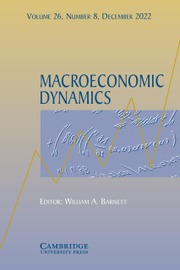No CrossRef data available.
Article contents
ARE UNIT ROOT TESTS USEFUL IN THE DEBATE OVER THE (NON)STATIONARITY OF HOURS WORKED?
Published online by Cambridge University Press: 23 October 2013
Abstract
The performance of unit root tests on simulated series is compared, using the business-cycle model of Chang et al. [Journal of Money, Credit and Banking 39(6), 1357–1373 (2007)] as a data-generating process. Overall, Monte Carlo simulations show that the efficient unit root tests of Ng and Perron (NP) [Econometrica 69(6), 1519–1554 (2001)] are more powerful than the standard unit root tests. These efficient tests are frequently able (i) to reject the unit-root hypothesis on simulated series, using the best specification of the business-cycle model found by Chang et al., in which hours worked are stationary with adjustment costs, and (ii) to reduce the gap between the theoretical impulse response functions and those estimated with a Structural VAR model. The results of Monte Carlo simulations show that the hump-shaped behavior of data can explain the divergence between unit root tests.
- Type
- Articles
- Information
- Copyright
- Copyright © Cambridge University Press 2013


